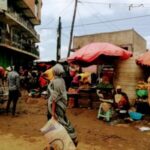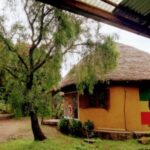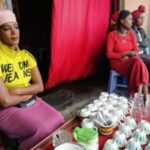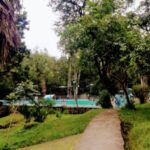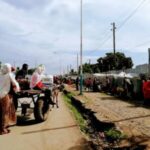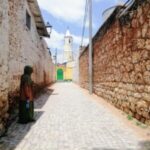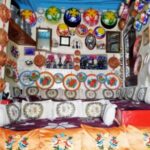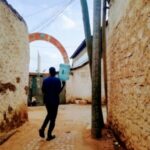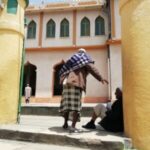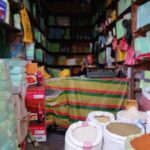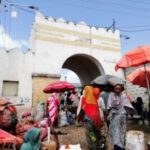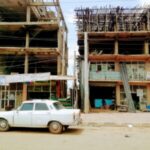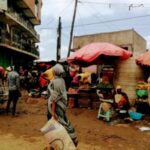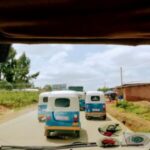by Silvia Orri
(2 – More) A little more than a year has passed since the ceasefire, but the problem is far from being resolved. Attacks, arrests and tensions between armed border forces are not uncommon. The northern part of Ethiopia is still not safe and travel there is often discouraged. The northern part. The breathtaking northern part: Lake Tana, the Gondar Plateau, Axum, Lalibela, the rock churches, the so-called “must see” destinations once you enter the country. Here is the dilemma: to risk or not to risk? Several travel agencies offer guided tours of the area, transportation is available and some accommodations are open. Several people I meet tell me about and show me the beauty of the Amara region. Others, however, strongly advise me not to go there. Tensions are still high and security is extremely precarious; just a few weeks earlier, some Dutch Red Cross workers had been stranded in Lalibela when the airport was stormed by militias and had to spend several nights trapped in hotels.
Traveling alone and without any connection or recommendation, I decided to head east and then south. I believe that as a tourist or traveler one must carefully evaluate the context in which one encounters, the desire to appear in a photo with the wonderful “African Jerusalem” behind one’s back must be able to give way to responsibility for those who live in those areas, understanding that our presence could alter balances/imbalances that we ignore. The salt of the travel season is the people and their stories, their feelings and their vision of the reality in which they are immersed, not selfies to gain approval and temporary self-esteem. The stories are priceless, precious, and most of all, they are around every corner if you have the patience to catch their whispers.
This is how I meet Zola, a driver who works in the Dancalia Depression, home to Africa’s deepest lake, Lake Assal, and one of the world’s most active volcanoes, Erta Ale. Originally from the capital, Zola makes no secret of the hardships of living in a region dominated by heat and drought, where temperatures can soar above 45°C during the dry season. Over the years, however, he has managed to juggle both traveling the many miles of basalt lava in the 4×4 of the tourist agency for which he works, as well as forging close relationships and adopting the lifestyle of the Afar people. A people who are mainly involved in the salt trade from the many salt lakes in the area and the animal trade with the nearby Djibouti border.
The view of the morphological and geological features of the area is impressive, a unique and hostile landscape for those who are not native. So Zola’s real job is not to drive and maintain the car, but to adapt to the climate, language, animist culture (he is an Orthodox Christian) and food of a population with whom he shares only Ethiopian citizenship on his papers, or little more. A few days later, I come into contact with Edom, a tour guide in the city of Harar.
Harar: Islam’s fourth holy city, a UNESCO World Heritage Site, and known locally as the City of Peace. It is obviously reductive to describe it with these three characteristics. What makes it attractive is not the awards, plaques and rankings, but the atmosphere created by centuries of cultural, linguistic and religious contamination, which has created an enveloping atmosphere of tolerance and reciprocity. Yemeni, Afghan, Egyptian, Turkish, Indian and West African merchants have traded there for centuries. Houses of worship of different religions stand side by side, different ways of cooking and processing raw materials coexist, accents and idioms mix like the sugar used to sweeten “Zebra”, a special variant of cappuccino typical of the region, made from beans of a variety called “Harar Coffee”.
If the ‘zebra’ is a way of drinking coffee, the camel is an important source of income and trade in the region. In fact, near Harar, in Babile, on the border with Somaliland, the largest camel market in Africa takes place every Monday and Thursday. The routes that bring buyers and sellers here are complex, very long and global. The deal is done on a handshake and a camel, whose meat is highly prized and can be worth between $2,000 and $6,800. Tensions with the border military are not sporadic, and there is a huge refugee camp in the area of people fleeing mainly from Somalia. As is so often the case, the layers of reality overlap and mix, making us realize that within a few square kilometers there can coexist quiet families who rent a room in their house to tourists arriving in Harar, and families for whom their home is instead a tent shared with dozens of other people.
Edom guides me through these contradictions, and his breaks are punctuated by meetings at friends’ homes to chew khat, a stimulant plant that is one of Ethiopia’s greatest economic resources, though considered illegal in some countries. His guidance is crucial to me, and he explains that his goal is to be his own “entrepreneur,” to set up his own travel agency based in Harar. Speaking five languages, he is a figurehead for the entire township community, managing museum admissions for arrivals, advising on where to stay, and organizing visits outside the city through an extensive network of acquaintances. Bureaucratic requirements are not an obstacle, as one might think from a European point of view, but the family pressure he has received to complete a certain type of studies has slowed down his path towards his tourism vocation, so that he now juggles between his relatives’ aspirations and his passion.
Continuing south, I arrive in lush green Shashamane and pick up Sandrine’s story. After marrying Alex, they set up their hospitality business, which gradually became a point of reference for the entire community of local Rastafarians.
After the Second World War, the Ethiopian Emperor Haile Selassie decided to donate the land around Shashamane to those who wanted to return from the African Diaspora: descendants of slaves who had been deported mainly to Central and South America. The impact on the local population was obviously not without misunderstandings, and the succession of governments that broke with Selassie’s policies created various difficulties in making the dream of the Promised Land and Pan-Africanism a reality. Disputes over land ownership, over income from trade in the goods grown on the land, and over cultural misunderstandings between native Ethiopians and “adopted” Ethiopians do not make life easy for the community.
In addition, corrupt administrations create inequalities that make living together even more difficult. Sandrine decided to lift the veil from the quiet and peaceful and seemingly carefree life that Rastafarians live. Her tourist reception business has managed to become a meeting place for resolving disputes between residents, for legal advice, for finding jobs for young adults who have left the school system or never entered it, for transportation to neighboring places. A kind of “social secretariat” that tends to calm situations that could lead to real tears between groups of people. It is also thanks to her that Shashamane continues to be a place for many to search for their roots, violated and broken by colonial activities and ideologies.
To learn more, read our Ethiopia conflict factsheet
Photos by Silvia Orri




















